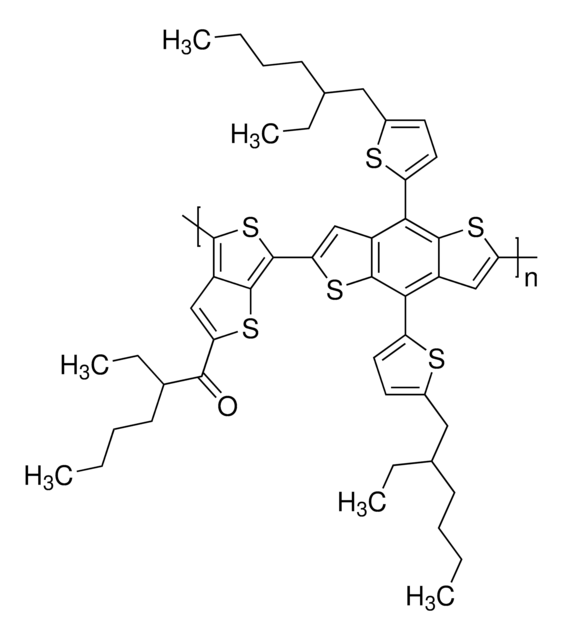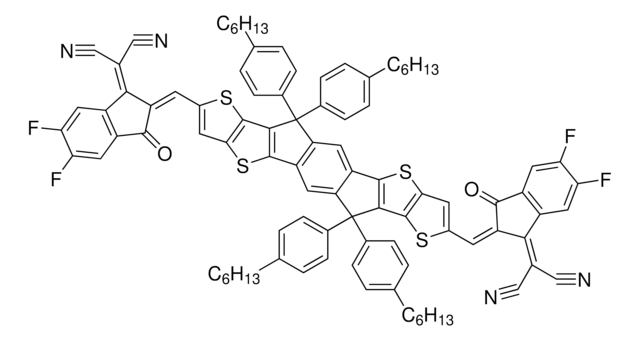772380
DTS(FBTTh2)2
Sinónimos:
7,7′-[4,4-Bis(2-ethylhexyl)-4H-silolo[3,2-b:4,5-b′]dithiophene-2,6-diyl]bis[6-fluoro-4-(5′-hexyl-[2,2′-bithiophen]-5-yl)benzo[c][1,2,5]thiadiazole], F-DTS, p-DTS(FBTTh2)2
About This Item
Productos recomendados
form
solid
solubility
chlorobenzene: 0.3-0.5% at 80 °C
dichlorobenzene: 0.3-0.5% at 80 °C
chloroform: soluble(lit.)
dichlorobenzene: soluble(lit.)
λmax
590 nm in chloroform
SMILES string
CCCCCCc1ccc(s1)-c2ccc(s2)-c3cc(F)c(-c4cc5c(s4)-c6sc(cc6[Si]5(CC(CC)CCCC)CC(CC)CCCC)-c7c(F)cc(-c8ccc(s8)-c9ccc(CCCCCC)s9)c%10nsnc7%10)c%11nsnc3%11
InChI
1S/C64H72F2N4S8Si/c1-7-13-17-19-23-41-25-27-49(71-41)51-31-29-47(73-51)43-33-45(65)57(61-59(43)67-77-69-61)53-35-55-63(75-53)64-56(79(55,37-39(11-5)21-15-9-3)38-40(12-6)22-16-10-4)36-54(76-64)58-46(66)34-44(60-62(58)70-78-68-60)48-30-32-52(74-48)50-28-26-42(72-50)24-20-18-14-8-2/h25-36,39-40H,7-24,37-38H2,1-6H3
Inchi Key
LNMKMESEJYZMDZ-UHFFFAOYSA-N
General description
Application
OPV Device Structure: ITO/MoOx/DTS(PTTh2)2: PC70BM/Al
- JSC = 12.8 mA/cm2
- VOC = 0.81 V
- FF = 0.68
- PCE = 7.0%
Storage Class
11 - Combustible Solids
wgk_germany
WGK 3
flash_point_f
Not applicable
flash_point_c
Not applicable
Certificados de análisis (COA)
Busque Certificados de análisis (COA) introduciendo el número de lote del producto. Los números de lote se encuentran en la etiqueta del producto después de las palabras «Lot» o «Batch»
¿Ya tiene este producto?
Encuentre la documentación para los productos que ha comprado recientemente en la Biblioteca de documentos.
Artículos
Solution-processed organic photovoltaic devices (OPVs) have emerged as a promising clean energy generating technology due to their ease of fabrication, potential to enable low-cost manufacturing via printing or coating techniques, and ability to be incorporated onto light weight, flexible substrates.
Nuestro equipo de científicos tiene experiencia en todas las áreas de investigación: Ciencias de la vida, Ciencia de los materiales, Síntesis química, Cromatografía, Analítica y muchas otras.
Póngase en contacto con el Servicio técnico
![[6,6]-Phenyl C71 butyric acid methyl ester 99%](/deepweb/assets/sigmaaldrich/product/structures/716/624/9fb9f2f0-ae99-429f-8d3a-b12267976a4d/640/9fb9f2f0-ae99-429f-8d3a-b12267976a4d.png)




![Poly[4,5-difluoro-2,2-bis(trifluoromethyl)-1,3-dioxole-co-tetrafluoroethylene] dioxole 87 mol %](/deepweb/assets/sigmaaldrich/product/structures/951/320/21327fcd-4960-402d-8ae1-bf2e379cb2e2/640/21327fcd-4960-402d-8ae1-bf2e379cb2e2.png)


